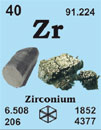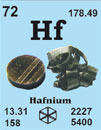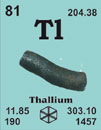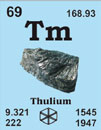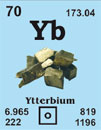& Kristalle GmbH

-
 English
English
-
 Deutsch
Deutsch
No products
Prices are tax excluded
Gallium (Ga)
We are a leading manufacturer and supplier of research materials
Gallium 31Ga69.723
Discovered in 1875 von Paul-Êmile Lecoq de Boisbaudran at Paris, France.
[Latin, Gallia = France]
French: gallium
German: Gallium
Italian: gallio
Spanish: galio
Description: Gallium is a soft, silvery-white metal, and has the longest liquid range of all the elements. It is stable in air and with water; it dissolves in acid and alkalis. Gallium has semiconductor properties, especially as gallium arsenide. It is used in light-emitting diodes and microwave equipment.
Further Materials properties
| Crystal structure: |
(cell dimensions/pm), space group, |
|---|---|
| X-ray diffractions mass absorption coefficients: | CuKa 67.9 (µ/r) / cm2g-1 MoKa 60.1 (µ/r) / cm2g-1 |
| Neutron scattering length: | 0.7288 b/10-12 cm |
| Thermal neutron capture cross-section: | 2.9 sa / barns |
| Density: | 5907 kg/m-3 [293 K]; 6113.6 [liquid at m.p.] |
| Melting point: | 29.78°C / 302.93°K |
| Boiling point: | 2402.85°C / 2676°K |
| Molar volume: | 11.81 cm3 |
| Thermal conductivity: | 40.6 [300 K] W m-1K-1 |
| Coefficient of linear thermal expansion: | 11.5 x 10-6 (a axis); 31.5 x 10-6 (b axis); 16.5 x 10-6 (c axis) K-1 |
| Electrical resistivity: | 27 x 10-8 [273 K] Ωm |
| Mass magnetic susceptibility: | -3.9 x 10-8(s) kg-1m3 |
| Young's modulus: | 9.81 GPa |
| Rigidity modulus: | 6.67 GPa |
| Bulk modulus: | n.a. |
| Poisson's ratio: | 0.47 GPa |
| Radi: | Ga3+ 62; Ga+ 113; atomic 122; covalent 125 |
| Electronegativity: | 1.81 (Pauling); 1.82 (Allred); ≤3.2 eV (absolute) |
| Effective nuclear charge: | 5.00 (Slater); 6.22 (Clementi); 6.72 (Froese-Fischer) |
| Number of Isotopes (incl. nuclear isomers): | 23 |
| Isotope mass range: | 62-> 83 |
Biological data
| Biological role: | None, but gallium acts to stimulate metabolism. |
|---|---|
| Toxicity | |
| Toxic intake: | < 15 mg kg-1 tolerated without apparent harm |
| Lethal intake: | LD50 (chloride, injection, rat) = 47 mg Kg-1 |
| Hazards: | Gallium salts generally have low toxicity. |
| Level in humans | |
| Blood: | <0.08 ppm |
| Bone: | n.a. |
| Liver: | 0.0025 ppm |
| Muscle: | 0.0014 ppm |
| Daily dietary intake: | n.a. but low |
| Total mass of element in average [70 kg] person: |
< 0.7 mg |
Geological data
| Minerals: | Gallium minerals are rare, but gallium occurs in other ores to the extent of 1%. | |||
|---|---|---|---|---|
| Mineral | Formula | Density | Hardness | Crystal apperance |
| Gallite | CuGaS2 | 4.40 (calc.) | 3 - 3.5 | tet., met. grey |
The ores diaspore, sphalerite, germanite and bauxite contain traces of gallium. Coal can also have a high gallium content.
| Chief ores: | Gallium is recovered as a by-product of zinc and copper refining |
|---|---|
| World production: | 30 tonnes/year |
| Main mining areas: | see copper and zinc. |
| Reserves: | n. a. |
| Specimen: | available as ingot, and as ultrapure gallium. Safe. |
| Abundances | |
|---|---|
| Sun: | 631 (relative to H = 1 x 1012) |
| Earth's crust: | 18 ppm |
| Seawater | 3 x 10-5 ppm |
| Residence time: | 10 000 years |
| Classification: | n.a. |
| Oxidation state: | III |
Source: Emsley, J. (1998) The Elements (3rd Edition)
Other sizes and specifications on request
Overview of elements with access to our shop
Fax: +49 (0) 2461 - 9352 - 11








































